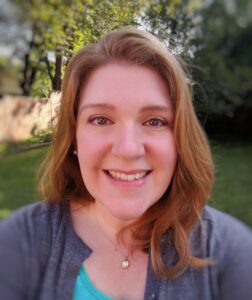7:00 – 7:30 pm: Recognition of the Gordon Award and ACS Volunteer of the Year Award
7:30 – 8:30 pm: Recognition of the Hillebrand Prize and awardee’s presentation
Dr. Marino will present, “Biophysical Measurement Innovation and its Centrality to Advancing Biotechnology“
This meeting is over — View the recording

Sara Orski, PhD
Charles L. Gordon Memorial Award
Dr. Sara Orski is recognized for her exemplary service to the profession of chemistry and to the Chemical Society of Washington. She has been a member of the Board of Managers since 2015 and has served as YCC Chair, and is currently a Councilor as well as the Publications committee chair. She is also an active member of the ACS Committee for Environmental Improvement (CEI) (2019-) and is a current program chair for the ACS Division of Polymer Chemistry (POLY).

Kim Morehouse, PhD
ACS Volunteer of the Year Award
Dr. Kim Morehouse has been the driving force behind the Chemical Society of Washington’s annual Chemists Celebrate Earth Week (CCEW) and National Chemistry Week (NCW) activities for the past 16 and 18 years, respectively. His efforts have impacted at least 3000 people in the past 5 years. He also ran the biannual illustrated poem contests (for K-12 students) for CCEW and NCW, actively recruited volunteers for the outreach activities, planned and prepared materials for demos and take-home bags, and partnered with other organizations for a broader participation. Kim has been instrumental in the success of these annual outreach events.

John P. Marino, PhD
Hillebrand Prize
Dr. John Marino is recognized for groundbreaking contributions to the field of biophysical characterization by high-resolution NMR and development of engineered protein reagents for next-gen proteomic measurements.
Dr. Marino will present, “Biophysical Measurement Innovation and its Centrality to Advancing Biotechnology“
Bio
Dr. John P. Marino currently serves as Co-Director of the Institute for Bioscience and Biotechnology Research (IBBR), a joint research institute of the University of Maryland and NIST and the Group Leader of the NIST Biomolecular Structure & Function Group at IBBR. He is also appointed Adjunct Professor in the Department of Chemistry and Biochemistry and is a member of the Molecular and Cell Biology Program at the University of Maryland. Prior to coming to NIST and the University of Maryland in 1997, Dr. Marino completed an A.B in Chemistry from Princeton University in 1989 and a Ph.D. in Chemistry from Yale University in 1995. He then held an Alexander von Humboldt post-doctoral fellowship for two years at the Goethe Universität in Frankfurt, Germany. Over his career, his research has involved the application of Nuclear Magnetic Resonance (NMR) and other biophysical methods to advance precision measurement of proteins and nucleic acids, with a particular focus on applications to therapeutics and vaccines. He has co-authored over 90 papers and 4 patent applications.
Abstract
At the center of advances in biotechnology often lies new experimental approaches, analysis tools and models that address critical gaps in measurement. Innovative approaches developed to address these measurement gaps can be underpinned by standards that establish trust and accelerate broad adoption through benchmarking and harmonization. In this talk, I will highlight examples from our group at NIST of measurement innovation and standards that support protein therapeutic development and next-generation protein sequencing. Protein therapeutics are a highly successful class of drugs that are currently used to treat a number of serious and life-threatening conditions such as cancer, autoimmune disorders, and infectious diseases (e.g., COVID-19). A critical requirement unique to protein therapeutics is that these drugs must adopt and retain the correct structural fold without forming unintended aggregates. The development of precision tools for characterization of the structure of protein therapeutics has therefore emerged as a major priority in the pharmaceutical industry. To address this gap, I will describe high-resolution NMR methods developed by our group for producing spectral ‘fingerprints’ that can be quantitatively assessed to reveal and classify variations in structure, and how these approaches are paving the way for broad use of NMR in the industry for assessment of protein therapeutics via chemometrics and machine learning that is both objective and automated. In the second part of the talk, I will describe next-generation approaches for protein sequencing based on fluorescence imaging of immobilized peptides that are emerging and have the potential to revolutionize the field in proteomics. A key technical challenge in implementing the fluoro-sequencing approach is achieving high-fidelity, sequential recognition and detection of specific amino acids that comprise the peptide sequence. To address this challenge, I will describe how our group is leveraging naturally occurring biomolecules that can function through selective recognition of (N)-terminal amino acids (NAAs) as starting points for engineering NAA-binders (NAABs) that are suitable for use as biotechnology reagents.




